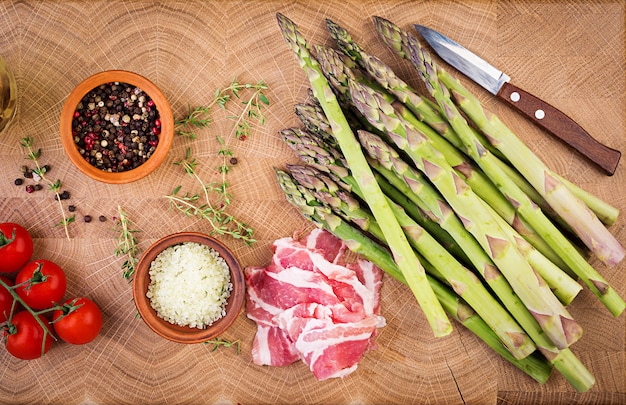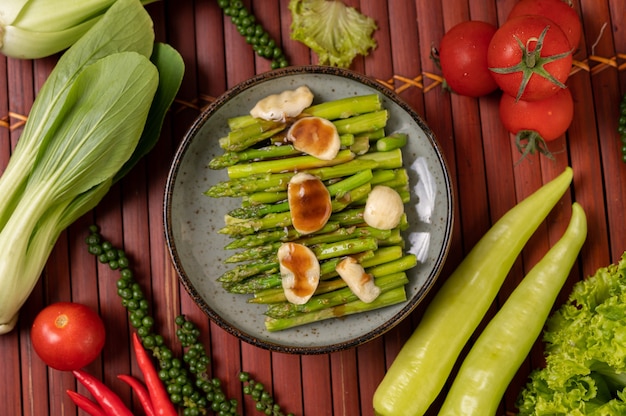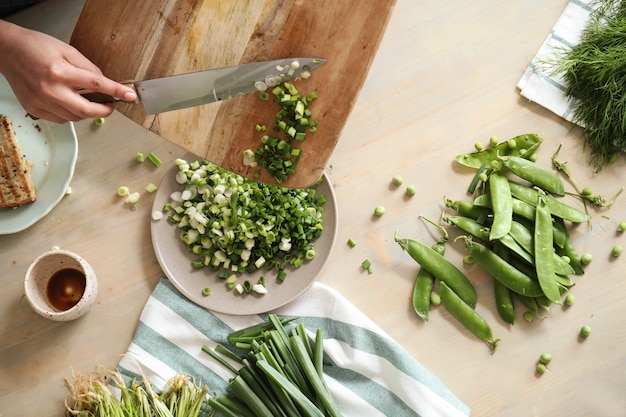Oh, asparagus. The mere mention of this springtime treasure sends a shiver of excitement down my spine. It’s a vegetable that can transform a simple meal into a culinary masterpiece. But, as any seasoned cook knows, getting those spears just right can be a bit of a culinary dance. So, gather 'round, my fellow food enthusiasts, because I’m about to spill the beans (pun intended!) on the secrets of cooking asparagus to perfection.
We’ll embark on a journey, from selecting the perfect bunch at the market to mastering different cooking techniques. I’ll share my favourite tips and tricks, address those pesky cooking mishaps, and even demystify the different types of asparagus. By the end of this guide, you’ll be an asparagus aficionado, ready to impress your friends and family with your newfound culinary expertise.
Part 1: Choosing the perfect asparagus

You know what they say, “You can’t make a silk purse out of a sow’s ear.” Well, the same applies to asparagus. Choosing the right bunch is crucial to achieving asparagus nirvana. So, here’s what to look for:
1.1 The “Snap Test”:
Before you even reach for a bunch, give it a gentle bend. A good asparagus spear should snap cleanly where the tender part meets the woody end. This “snap test” is a surefire way to determine freshness.
1.2 Colour Counts:
A vibrant, uniform green colour is a sign of peak freshness. Avoid bunches with brown or yellow spots, which indicate over-ripeness.
1.3 Those Tightly Closed Tips:
The tips of the spears should be tightly closed and pointed. Open or mushy tips are a sign that the asparagus has been hanging around for a bit too long.
1.4 Freshly Cut Ends:
Check the ends of the spears. They should be freshly cut, not dry or withered. This indicates that the asparagus is relatively fresh and hasn’t been sitting around for too long.
Now that you’ve chosen the perfect bunch, let’s prep it for cooking!
Part 2: Prepping Asparagus - A Skill Worth Mastering

Prepping asparagus is a little ritual I enjoy. There's something oddly satisfying about snapping off those woody ends. Here's my fool-proof method:
2.1 The Art of Snapping:
Hold the asparagus spear at both ends, and gently bend it. The spear will naturally snap where the woody bit ends, revealing the tender, delicious part. This is my go-to method, as it’s quick and easy, and you're guaranteed to get rid of the tough ends.
2.2 Precision Trimming:
For those who prefer a more precise approach, you can trim the asparagus ends with a knife. Simply cut off the bottom inch or so, depending on the thickness of the spear.
2.3 A Gentle Wash:
Give your asparagus a good wash under cold running water to remove any dirt or debris. Avoid soaking them in water for too long, as they can become waterlogged.
Now, let's dive into the heart of the matter: cooking asparagus!
Part 3: Cooking Asparagus - A Symphony of Flavors

Asparagus is like a blank canvas, waiting for your culinary creativity to shine. There are so many delicious ways to cook it, each revealing a unique dimension of its flavour. Here’s a rundown of my favourite techniques:
3.1 Roasting - A Classic Approach
Roasting brings out the sweetness and enhances the natural flavour of asparagus. It’s a classic method that never fails to impress:
Roasting Instructions:
- Preheat your oven to 200°C (400°F). This high temperature ensures a crispy exterior and tender interior.
- Toss the asparagus with olive oil, salt, and pepper. I like to add a squeeze of lemon juice for a bit of acidity, which cuts through the sweetness and adds a fresh touch.
- Spread the asparagus on a baking sheet in a single layer. This ensures even cooking and prevents the spears from steaming instead of roasting.
- Roast for 10-15 minutes, or until tender-crisp. Keep an eye on it, as cooking times can vary depending on the thickness of the spears.
For a more intense flavour, try adding herbs like rosemary or thyme to the roasting pan. A sprinkle of Parmesan cheese before serving elevates the dish to another level.
3.2 Grilling - A Smoky Delight
If you’re looking for a smoky, charred flavour, grilling is the way to go. While you can grill over charcoal or gas, I prefer to use a grill pan for a more even and controlled cook:
Grilling Instructions:
- Preheat your grill pan over medium-high heat. A hot pan ensures beautiful grill marks and quick cooking.
- Toss the asparagus with olive oil, salt, and pepper. This creates a flavorful coating and prevents the spears from sticking to the pan.
- Grill the asparagus for 3-5 minutes per side, or until tender-crisp and slightly charred. Flip them once for even browning.
A sprinkle of smoked paprika or a drizzle of balsamic glaze after grilling adds a gourmet touch. Serve it with a dollop of creamy goat cheese or a tangy vinaigrette for a perfect bite.
3.3 Steaming - A Delicate Touch
Steaming is a gentle cooking method that retains the asparagus's bright green colour and delicate flavour. It’s a perfect option for those who prefer a lighter, healthier approach:
Steaming Instructions:
- Fill a saucepan with about an inch of water. Add a steamer basket on top.
- Bring the water to a boil. The steam will cook the asparagus evenly and quickly.
- Add the asparagus to the steamer basket and cover the saucepan. Steam for 4-6 minutes, or until tender-crisp.
You can add herbs like dill or tarragon to the water for a fragrant twist. steamed asparagus pairs well with lemon butter sauce, a simple vinaigrette, or a sprinkle of toasted sesame seeds.
3.4 Stir-Frying - A Speedy Option
Stir-frying is a quick and easy way to cook asparagus. It’s perfect for adding to a stir-fry or using as a side dish:
Stir-Frying Instructions:
- Heat a wok or large frying pan over high heat. A hot pan is crucial for achieving a quick, even cook.
- Add a tablespoon of oil to the pan. Use a neutral oil with a high smoke point, like peanut or canola oil.
- Add the asparagus and stir-fry for 2-3 minutes, or until tender-crisp. Keep stirring to prevent burning.
You can add garlic, ginger, or chilli flakes to the pan for extra flavour. Stir-fried asparagus pairs well with soy sauce, sesame oil, or a splash of rice wine vinegar.
Part 4: Knowing When Asparagus is Cooked - The Art of Perfect Doneness
Here’s where things get a bit tricky. You don’t want to overcook asparagus and end up with a mushy mess. But, you also don't want it to be too crunchy. The key is achieving that perfect tender-crisp texture. Here’s how to know when it’s ready:
4.1 The “Snap Test” - A Reliable Indicator:
This is my go-to method. Take a spear of asparagus and gently snap it in half. If it snaps cleanly, it’s cooked. If it bends and doesn't break, it needs more time.
4.2 The “Fork Test” - A Simple Check:
You can also test the asparagus with a fork. It should pierce through easily but still offer a bit of resistance. If it feels mushy, it's overcooked.
4.3 The “Colour Check” - A Visual Cue:
Asparagus should turn a vibrant green when it’s cooked. If it’s still bright green, it needs more time. If it’s turning a bit brown, it’s probably overcooked.
Part 5: Common Asparagus cooking mistakes - Lessons Learned
Even the most experienced cooks have their fair share of culinary mishaps. Here are some common asparagus cooking blunders and how to avoid them:
5.1 Overcooking - The Enemy of Tender-Crisp Texture:
Asparagus can easily become mushy if you overcook it. Always follow the cooking times carefully and use the “snap test” or “fork test” to check for doneness.
5.2 Undercooking - A Tough and Stringy Tragedy:
Undercooked asparagus can be tough and stringy. Be sure to cook it long enough to achieve a tender-crisp texture.
5.3 Not Seasoning Properly - A Missed Opportunity for Flavor:
A little salt and pepper can go a long way. Season your asparagus generously before cooking, and feel free to add other herbs and spices for extra flavour. Don’t be afraid to experiment with different flavour combinations.
5.4 Not Serving It Hot - A Diminished Culinary Experience:
Asparagus tastes best when served hot. If you’re not serving it immediately, keep it warm in a low oven or on a warming tray.
5.5 Using the Wrong Serving Method - An Underappreciated Vegetable:
Asparagus is best served as a side dish or as part of a larger meal. Don’t be afraid to get creative and experiment with different sauces and toppings.
Part 6: The Different Types of Asparagus - Exploring the Variety
Did you know there are different types of asparagus? While the most common variety is green asparagus, there are also white and purple asparagus, each with its unique characteristics and flavours. Let’s explore them:
6.1 Green Asparagus - The Classic:
The most common type, with a delicate flavour and a bright green colour. It’s generally available throughout the spring and summer months.
6.2 White Asparagus - The Earthy Wonder:
A rarer variety, grown underground and blanched to retain its white colour. White asparagus has a more earthy flavour and a slightly sweeter taste. It’s often enjoyed during the spring season, particularly in Europe.
6.3 Purple Asparagus - The Colourful Surprise:
A hybrid variety with a purple-hued exterior and a green interior. It has a slightly sweeter flavour than green asparagus, and its colour intensifies when cooked.
Experiment with different types to find your favourite. You might be surprised by what you discover.
Part 7: Storing Asparagus - Preserving Freshness
Once you’ve bought your asparagus, it’s important to store it properly to keep it fresh and prevent it from wilting. Here’s how to do it right:
7.1 Refrigerate it - The Cool and Moist Environment:
Store asparagus in the refrigerator crisper drawer. Wrap the ends in a damp paper towel and place the bunch upright. This helps to keep the asparagus hydrated and prevents the ends from drying out.
7.2 Don’t Wash It Before Storing - Avoid Unnecessary Sogginess:
Wash asparagus just before cooking. Washing it too early can lead to it becoming soggy.
7.3 Avoid Storing it in Plastic Bags - No Need for Moisture Trapping:
Plastic bags trap moisture and can cause asparagus to rot. Use a paper towel instead.
Part 8: Serving Asparagus - A Culinary Art Form
Now that you've mastered the art of cooking asparagus, it's time to serve it up. Here are some serving ideas to inspire you:
8.1 Simple and Elegant - The Essence of Flavor:
Serve roasted or grilled asparagus as a simple side dish. A drizzle of olive oil, a squeeze of lemon juice, and a sprinkle of salt and pepper are all you need to enhance its natural flavour.
8.2 Fancy Flair - A Gourmet Touch:
For a more sophisticated touch, try serving asparagus with hollandaise sauce, béarnaise sauce, or a balsamic glaze. You can also add a sprinkle of Parmesan cheese or toasted almonds for extra flavour and texture.
8.3 Creative Combinations - A culinary journey:
Asparagus pairs well with a variety of ingredients, including eggs, seafood, chicken, and pasta. Get creative and experiment with different flavour combinations.
Here’s a table showing typical cooking times for asparagus based on its thickness and cooking method:
| Thickness | Roasting | Grilling | Steaming | Stir-Frying |
|---|---|---|---|---|
| Thin | 8-10 minutes | 3-4 minutes | 3-4 minutes | 2-3 minutes |
| Medium | 10-12 minutes | 4-5 minutes | 4-5 minutes | 3-4 minutes |
| Thick | 12-15 minutes | 5-6 minutes | 5-6 minutes | 4-5 minutes |
Remember, these are just guidelines. Always check for doneness using the “snap test” or “fork test” to ensure your asparagus is cooked to your liking.
FAQs
Let's address some common asparagus questions you might have:
1. Can I eat the asparagus skin?
Yes, you can eat the skin. In fact, it contains valuable nutrients, including fibre and antioxidants. However, the skin can be a bit tough, so some people prefer to peel it off, especially for thicker asparagus spears. If you’re not sure, try a small piece first. You can use a vegetable peeler to remove the skin for a smoother texture.
2. How do I store asparagus after it's been cooked?
Cooked asparagus can be stored in the refrigerator for up to 3 days. Place it in an airtight container or wrap it tightly in plastic wrap. It's best to reheat it gently in the oven or microwave.
3. What if my asparagus tastes bitter?
Asparagus can sometimes have a bitter taste, especially if it’s older. To reduce bitterness, try soaking it in cold water for 30 minutes before cooking. You can also add a pinch of sugar to the cooking water or a squeeze of lemon juice to balance out the bitterness.
4. Can I freeze asparagus?
Yes, you can freeze asparagus, but it's best to blanch it first. This helps to preserve its colour and texture. Blanch the asparagus for 2-3 minutes, then plunge it into ice water. Drain it thoroughly and spread it out on a baking sheet lined with parchment paper. Once it's frozen solid, transfer it to freezer bags. Frozen asparagus can be stored for up to 6 months.
5. What are some other ways to use asparagus?
Aside from cooking it as a side dish, you can also use asparagus in soups, stews, risottos, quiches, and even pasta dishes. It adds a delightful flavour and texture to various culinary creations.
Now, I hope you’re ready to embrace the world of asparagus with confidence! Let me know how your asparagus adventures turn out. Happy cooking, my fellow food lovers!
Everyone is watching

Corn on the Cob: The Ultimate Guide to Perfectly Cooked Ears
Healthy MealsAh, corn on the cob. Just the name evokes images of sunny days, barbecues, and that sweet, juicy flavour that ...

Perfect Pork Roast Oven Cooking Time: A Guide to Delicious Results
Healthy MealsThere's something truly satisfying about a perfectly roasted pork. The aroma alone is enough to make your mout...

Ham Cooking Time: How Long to Bake, Smoke, or Boil a Delicious Ham
Healthy MealsAh, ham. It's a classic, isn't it? A real crowd-pleaser, especially around holidays. And when done right, it'...

Scallops: The Ultimate Guide to Perfect Cooking
Healthy MealsAh, scallops. Those delicate, sweet, and utterly delicious morsels of the sea. They hold a special place in my...

Spaghetti Squash: The Ultimate Guide to Cooking and Serving
Healthy MealsRemember that time you saw spaghetti squash at the supermarket, looking all bumpy and strange, and thought, "W...
